Oxide dispersion strengthened (ODS) steels for nuclear applications
However, there are now encouraging signs that tomorrow may be about to arrive, in that the nuclear power sector has identified the need in the next generation of nuclear fission reactors for a material with a combination of properties that ODS steels would be ideally placed to deliver.
Dr David Whittaker reports exclusively for ipmd.net on a paper from N Garcia-Rodriguez, L Fuentes-Pacheco, M Campos and J M Torralba (Universidad Carlos III de Madrid, Spain) at the Euro PM 2011 Conference, held in Barcelona, 9-12 October 2011, discussing work on developing new ODS ferritic steels based on Fe-20Cr-5Al prealloyed powders.
Development of New ODS Ferritic Steels Based on Fe-20Cr-5Al Prealloyed Powders by Mechanical Alloying
The so-called Generation III+ reactors will operate at significantly higher temperatures than the current generation of reactors. This is creating a potential demand for fuel cladding materials with higher temperature capability than those currently used.
ODS steels are being proposed as the materials to satisfy these demands on the basis that they could deliver enhanced high temperature creep strengths, but also because they would have the ability to control irradiation damage, as the resultant gas bubbles are formed around the dispersed oxide particles rather than at grain boundaries.
The prime route for producing ODS steels starts with the incorporation of the reinforcing oxide additions into the matrix steel by the mechanical alloying of particulate materials.

Table 1 Experimental parameters of the milled alloys studied (From paper by N Garcia-Rodriguez et al, ‘Development of New ODS Ferritic Steels Based on Fe-20Cr-5Al Prealloyed Powders by Mechanical Alloying’ presented at Euro PM2011 Conference. Published in the Conference Proceedings by EPMA, UK)
In the reported work, both planetary ball milling and attritor ball milling have been used in mechanical alloying to produce two different alloys. These alloys were based on a prealloyed Fe-20Cr-5Al base powder, in which were incorporated additions of W (3 wt%), Ti (0 and 0.4wt%) and Y2O3 (yttria) (0.25wt%) (see Table 1).
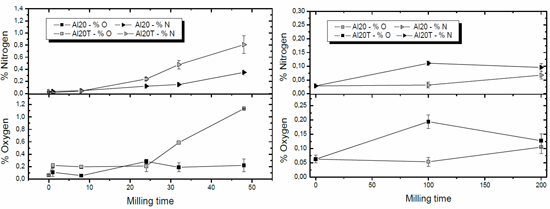
Fig. 1 Changes in oxygen and nitrogen content with milling time – planetary milling (left) and attritor milling (right). (From paper by N Garcia-Rodriguez et al, ‘Development of New ODS Ferritic Steels Based on Fe-20Cr-5Al Prealloyed Powders by Mechanical Alloying’ presented at Euro PM2011 Conference. Published in the Conference Proceedings by EPMA, UK)
It is known that ODS materials can exhibit poor impact properties and a high ductile-brittle transition temperature and the origin of these issues has been attributed to the pick-up of interstitial oxygen and nitrogen in the mechanical alloying process. The levels of oxygen and nitrogen during planetary ball milling and attritor milling were therefore assessed (Fig. 1). These results showed that the interstitial contents in all alloys increased with milling time, but that this effect was more evident in planetary milling, because the atmosphere in the mill was static in this case.
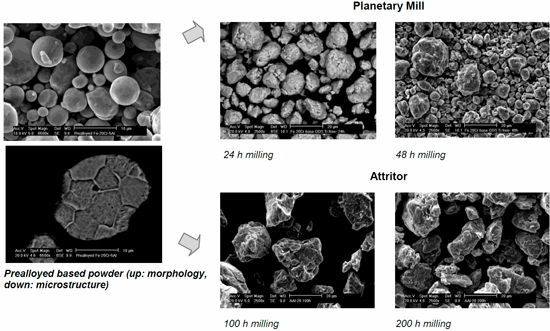
Fig. 2 SEM images of the starting powder and milled powders (From paper by N Garcia-Rodriguez et al, ‘Development of New ODS Ferritic Steels Based on Fe-20Cr-5Al Prealloyed Powders by Mechanical Alloying’ presented at Euro PM2011 Conference. Published in the Conference Proceedings by EPMA, UK)
The evolution in powder morphology during milling was studied by SEM. As shown in Fig. 2, the starting pre-alloyed powder is spherical, but, during the high energy milling, particles are flattened, cold welded, fractured and re-welded, creating a more irregular morphology.
The changes in particle size during milling are shown in Fig. 3. At the first stage of milling, plastic deformation and welding mechanisms predominate and particle size coarsens. Later, with increasing strain hardening of the particles, fracture becomes more important and finer sizes are created.
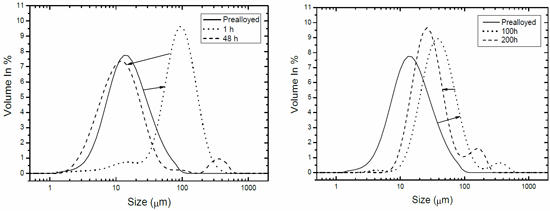
Fig. 3 Evolution of particle size distribution in planetary milling (left) and attritor milling (right). (From paper by N Garcia-Rodriguez et al, ‘Development of New ODS Ferritic Steels Based on Fe-20Cr-5Al Prealloyed Powders by Mechanical Alloying’ presented at Euro PM2011 Conference. Published in the Conference Proceedings by EPMA, UK)
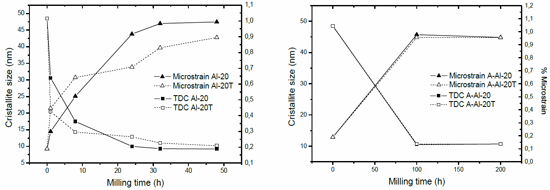
Fig. 4 Variations of crystallite size and microstrain with milling time in planetary milling (left) and attritor milling (right) (From paper by N Garcia-Rodriguez et al, ‘Development of New ODS Ferritic Steels Based on Fe-20Cr-5Al Prealloyed Powders by Mechanical Alloying’ presented at Euro PM2011 Conference. Published in the Conference Proceedings by EPMA, UK)
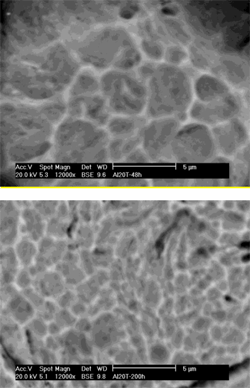
Fig. 5 SEM images of microstructures of
Al-20T-48h (upper image) and A-Al-20T
-200h (lower image) and the final stage of
each of the milling methods. (From paper
by N Garcia-Rodriguez et al, ‘Development
of New ODS Ferritic Steels Based on Fe-20Cr
-5Al Prealloyed Powders by Mechanical
Alloying’ presented at Euro PM2011
Conference. Published in the Conference
Proceedings by EPMA, UK)
The changes in microstructure of the powder particles were assessed, using X-ray diffraction analysis, to track two crystallographic parameters that are sensitive to the effects of the high energy milling – crystallite size and level of microstrain (Fig 4).
During the early stages of milling, the crystallite size of all alloys reduced rapidly to around 10-15 nm and then remained constant with longer milling times. As crystallite size reduced in the early stages of milling, the microstrain increased to a maximum value of around 1%.
Both milling processes created a uniform distribution of W, Y and O in each Fe base system. Fig. 5 shows the microstructures of mounted and polished powders.
Even though particle size distribution and crystallite size were slightly lower in the samples processed by planetary ball milling, the grain size attained was finer with attritor milling. This fact, coupled with the lower levels of interstitial pick-up in milling, has indicated that attrition is the more effective method for the mechanical alloying of these ODS ferritic powders.
News | Articles | Market reviews | Search directory | Subscribe to e-newsletter





